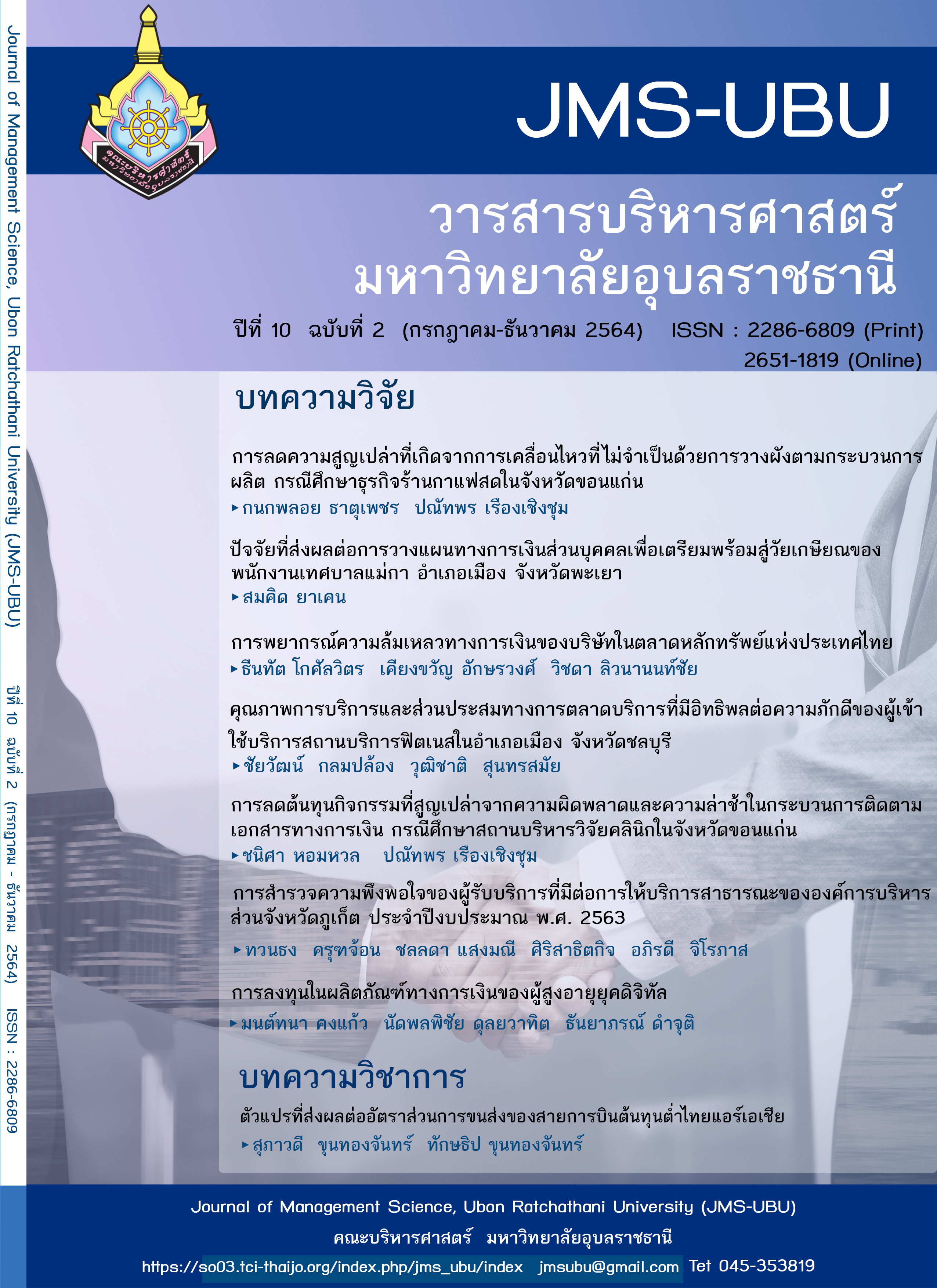การลดความสูญเปล่าที่เกิดจากการเคลื่อนไหวที่ไม่จำเป็นด้วยการวางผังตามกระบวนการผลิต กรณีศึกษาธุรกิจร้านกาแฟสดในจังหวัดขอนแก่น
Main Article Content
บทคัดย่อ
การลดความสูญเปล่าที่เกิดจากการเคลื่อนไหวที่ไม่จำเป็นช่วยให้สามารถลดระยะทางและลดระยะเวลาในการปฏิบัติงาน งานวิจัยนี้จึงมีวัตถุประสงค์เพื่อศึกษาความสูญเปล่ารวมถึงวิเคราะห์สาเหตุ เพื่อเสนอแนวทางการลดความสูญเปล่าที่เกิดจากการเคลื่อนไหวที่ไม่จำเป็นด้วยการวางผังตามกระบวนการผลิต ตามหลักกระบวนการคิดแบบ Agile Manifesto ด้วยการนำกระบวนการคิดแบบลีนในเรื่องของการลดความสูญเปล่าเข้ามาใช้ โดยรวบรวมข้อมูลด้วยการสังเกตแบบมีส่วนร่วมและการสนทนากลุ่มแบบกลุ่มขนาดเล็กร่วมกับการวิเคราะห์ด้วยแผนผังงานบริการ แผนภูมิกระบวนการไหล คำนวณหาจำนวนรอบที่เหมาะสม การวิเคราะห์คุณค่ากิจกรรม รวมถึงผังการดำเนินการและแผนภูมิต้นไม้ร่วมกับ 5 Whys ผลการวิจัยพบว่าความสูญเปล่าเกิดจากกิจกรรมที่เกี่ยวข้องกับการเคลื่อนย้ายอุปกรณ์ต่าง ๆ ที่ใช้ในกระบวนการผลิต ซึ่งเกิดจากสาเหตุการจัดวางผังตามกระบวนการผลิตที่ไม่เหมาะสม ผู้วิจัยจึงเสนอแนวทางการลดความสูญเปล่าที่เกิดจากการเคลื่อนไหวที่ไม่จำเป็นด้วยการวางผังตามกระบวนการผลิต พบว่า สามารถลดระยะทางจาก 23.2 เมตร เป็น 12.06 เมตร ทำให้ลดระยะเวลาลงจาก 3.01 เป็น 2.15 นาทีต่อแก้วจากการวิจัยนี้พบว่าผู้ประกอบการควรให้ความสำคัญต่อการลดความสูญเปล่าที่เกิดจากการเคลื่อนไหวที่ไม่จำเป็นด้วยการวางผังตามกระบวนการผลิต ซึ่งจะเป็นประโยชน์ต่อการตอบสนองการให้บริการอย่างรวดเร็วของธุรกิจร้านกาแฟสดต่อไป
Downloads
Article Details
เอกสารอ้างอิง
กรมพัฒนาธุรกิจการค้า. (2562). ธุรกิจผลิตกาแฟ บทวิเคราะห์ธุรกิจ ประจำเดือน มกราคม 2562. สืบค้นเมื่อ 22 พฤษภาคม 2563. จาก https://www.dbd.go.th/download/document_file/Statisic/2562/
T26/T26_201901.pdf
ฝ่ายบริหารห้างหุ้นส่วนจำกัดไดมอนด์กรุ๊ป999. (2563). บันทึกการตรวจสอบมาตรฐานสาขาร้านกาแฟสดของห้างหุ้นส่วนจำกัดไดมอนด์กรุ๊ป999 ประจำปี พ.ศ. 2562 ถึง พ.ศ. 2563
รัชต์วรรณ กาญจนปัญญาคม. (2552). การศึกษางานอุตสาหกรรม (พิมพ์ครั้งที่1). กรุงเทพฯ: สำนักพิมพ์ท้อป.
ศูนย์วิจัยกสิกรไทย. (2561). ธุรกิจร้านกาแฟบริหารอย่างไรให้รุ่ง. สืบค้นเมื่อ 22 พฤษภาคม พ.ศ.2563. จาก https://kasikornbank.com/th/business/sme/KSMEKnowledge/article/KSMEAnalysis/Documents/Coffee-Shop-Management.pdf
สุภัทรพงษ์ สนอุทา และปณัทพร เรืองเชิงชุม . (2563). การลดความสูญเปล่าที่เกิดจากความล่าช้าในกระบวนการติดตามเอกสารทางการเงินด้วยการประยุกต์ใช้แนวคิดห่วงโซ่อุปทาน 4.0. วารสารบริหารศาสตร์ มหาวิทยาลัยอุบลราชธานี, 9(1), 38-54.
Åberg, H. (2019). Layout Redesign and Automation for a Lean Packing Process in a Distribution Center. (Master’s thesis). Lund University, M.Sc. in Industrial Engineering and Management, Department of Industrial Management and Logistics,
Andrea, C. (2012). Lean organization: from the tools of the Toyota Production System to lean office. Springer Science & Business Media: Springer-verlag italia.
Carlo, F. D., Arleo, M. A., Borgia, O., & Tucci, M. (2013). Layout design for a low capacity manufacturing line: A case study. International Journal of Engineering Business Management, 5(special issue), 1-10.
Dinulescu, R. (2016). Analyzing the Romanian healthcare bureaucracy using a tree diagram. Ovidius University Annals, Economic Sciences Series, 16(1), 158-162.
Goel, P. & Kleiner, B. (2015). Achieving excellence in lean manufacturing. Franklin Business & Law Journal, 2015(1), 110-118.
Heizer, J., Render, B. & Munson, C. (2017). Principles of Operations management: Sustainability and Supply Chain Management, 10th ed. New York: Pearson.
Kitriastika, V., Tanaya, P. I., & Indrayadi, Y. (2013). A redesign layout to increase productivity of a company. Jurnal Ilmiah Teknik Industri, 12(1), 83-95.
Kovács, G. (2019). Layout design for efficiency improvement and cost reduction. Bulletin of the Polish Academy of Sciences Technical Sciences, 67(3), 547-555.
Murugaiah, U., Benjamin, S. J., Marathamuthu, M. S., & Muthaiyah, S. (2010). Scrap loss reduction using the 5 whys analysis. International Journal of Quality & Reliability Management, 27(5), 527-540.
Nittaya Ngampak & Busaba Phruksaphanrat (2010). Cellular manufacturing layout design and selection: A case study of electronic manufacturing service plant. In World Congress on Engineering 2012. July 4-6, 2012. London, UK. (Vol. 2189, pp. 1182-1187). International Association of Engineers.
Patel, D., Ranpuria, H., Shah, J. & Fournier, J. (2013). The Book of Value Stream Maps I. Mason: The Evsm Group.
Putri, N.T., & Dona, L.S. (2019). Application of lean manufacturing concept for redesigning facilities layout in Indonesian home-food industry: A case study. The TQM Journal, 31(5), 815-830.
Sabet, E., Adams, E., & Yazdani, B. (2016). Quality management in heavy duty manufacturing industry: TQM vs. Six Sigma. Total Quality Management & Business Excellence, 27(1-2), 215-225.
Sobrino, D. R. D., Holubek, R., Kostal, P., & Ruzarovsky R. (2014). Layout redesign and material flow analysis Fat a flexible assembly cell supported by the use of simulation. Applied Mechanics and Materials, 693, 22-29.
Stellman, A. & Greene, J. (2013), Learning Agile: Understanding Scrum, XP, Lean, and Kanban, 1st ed. California: O'Reilly Media, Inc.
Sundin, E., Björkman, M., Eklund, M., Eklund, J., & Engkvist, I. L. (2011). Improving the layout of recycling centres by use of lean production principles. Waste Management, 31(6), 1121-1132.
Wang, L. (2011). Combining facility layout redesign and dynamic routing for job-shop assembly operations. In IEEE International Symposium on Assembly and Manufacturing (ISAM), (pp. 1-6).Tampere, Finland.

